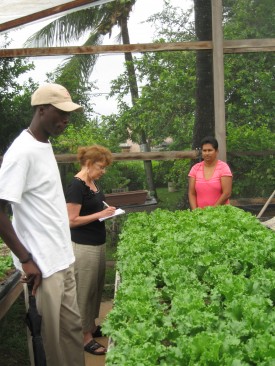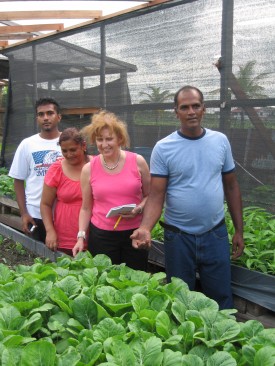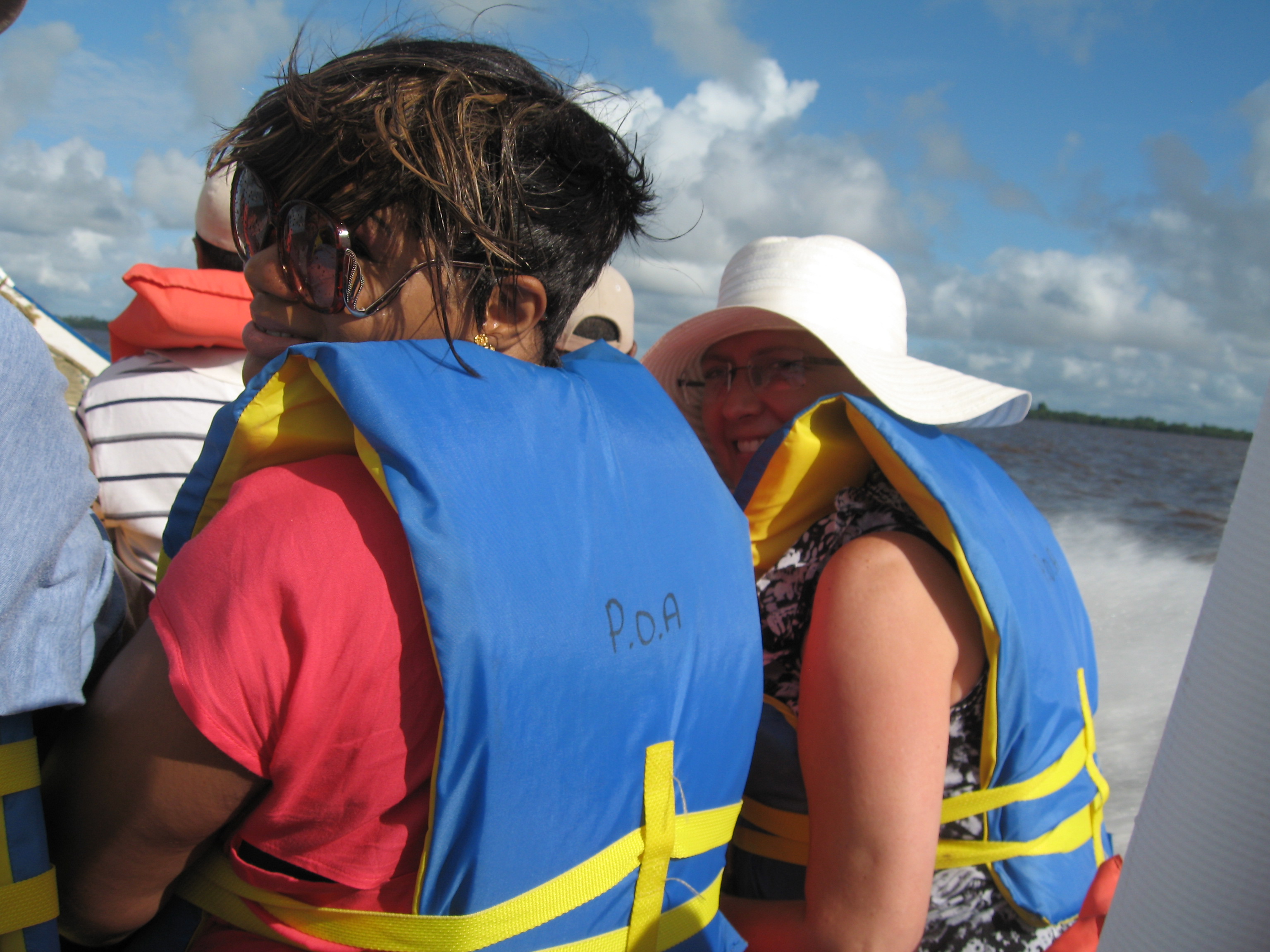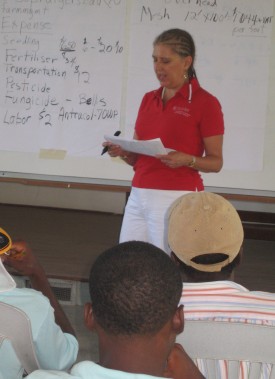
Robin Brumfield takes notes from Region 4 shadehouse producer Shiromanie Isaacs. At left is Ryan Nedd, field officer with the Farmer to Farmer project.
One year ago, Rutgers specialist in farm management Robin Brumfield found herself enjoying the cooling spray of the brackish brown water as she sped along in a 15-seater speedboat on the Essequibo River. The “Mighty Essequibo” as it’s called, is the third largest river on the continent of South America and the largest in Guyana, the only English-speaking country on the continent.
Winding its way north for over 600 miles through some of the more remote areas of Guyana, the Essequibo River flows around more than 365 distinct islands. On this occasion, Brumfield and several Guyanese field staff from an internationally funded farming project were skirting the largest of the three biggest islands located in the 20-mile wide mouth of the Essequibo River, just before it empties into the Atlantic Ocean.
Far from her New Brunswick, New Jersey, campus home of the Rutgers School of Environmental and Biological Sciences, Brumfield was in Guyana in 2012 to conduct training to boost the operations of hydroponic vegetable greenhouse growers. For two weeks in May, she traveled to several regions of Guyana, including some of the more remote parts of Region 2, Essequibo, to teach local growers as well as program staff about cost analysis, developing budgets for vegetable crops and business planning under a fledgling “Hydroponic Shadehouse (Greenhouse) Vegetable Production and Marketing Project.”
In Guyana, hydroponics or “soilless” cultivation is being introduced as an alternative vegetable production system of growing plants without soil, a practice being adopted by small farmers and non-farmers alike for cash-crops like celery, lettuce, bok choy, tomatoes and peppers. When paired with the protective shadehouse (greenhouse), this hydroponic technique is growing in popularity, in large part because it is possible to produce fresh, healthy vegetables throughout the year, a prospect that is attractive even to non-farmers doing gardening at home.
Crossing the Essequibo River in Region 2, Guyana
So far, most of the producers grow a limited range of cash-crops under shadehouses in shallow, raised beds to avoid heavy pest infestation on the ground in this tropical climate and to avoid potential flooding from heavy downpours, especially during the extensive rainy season.
While a few of the small-scale producers use the traditional hydroponic method of growing in water enhanced with inputs, the vast majority of those participating in the pilot project use a substrate of sand mixed with paddy husks (rice hulls), the by-product from the production of rice, one of the main agricultural crops grown in Guyana.
“I was impressed with the simplicity and appropriateness of the technology to the country—using food crops that Guyanese already eat, using local materials like paddy husks (rice hulls), using organic and locally-produced pesticides—to make shadehouse vegetable production cost effective and doable with a high probability of success for farmers and non-farmers,” said Brumfield.
With more than 35 years of experience in greenhouse production and management in the U.S., Brumfield was a natural fit for this project in Guyana as she has helped greenhouse owners to make effective managerial decisions to sustain their operations. She developed “Greenhouse Cost Accounting,” a computer program that allows greenhouse managers to allocate costs to specific crops that has become the standard for the greenhouse industry.
Brumfield recalled how excited she was to be chosen for last year’s international project sponsored by the Partners of the Americas’ Farmer to Farmer program, which is supported by the U.S. Congress and USAID as part of the U.S. foreign assistance program. The Farmer to Farmer program brings together agricultural professionals and practitioners from the U.S. and the Caribbean to serve as volunteers, working with farmers and agribusiness owners in Latin America and the Caribbean to identify local needs and design projects to address them.
“What stood out for me was the sacrifice that so many of the small farmers had to make to produce their crops and get them to the market, especially those in the remote areas,” said Brumfield. “Their interest in learning all they can to make their small-scale operation profitable was well worth my trip and I was grateful to the Farmer to Farmer program for allowing me to share my expertise.”
Brumfield noted the lack of widespread training in agriculture or economics among the young staff but had high hopes for the new hydroponic initiative because of the expertise and leadership of Kelvin Craig, who earned both his bachelor’s and master’s degrees in Agricultural Economics from Purdue University. Craig is the country coordinator for the Farmer to Farmer program. “Kelvin’s assembled a great, young staff to spread the program to the average Guyanese in the face of what we might consider significant obstacles—poverty, lack of robust industry, remoteness of some locations and access to markets,” said Brumfield. “Let’s not forget the mosquitoes,” she added, jokingly.

Family producers, led by Mahendra Sookraj, show Robin Brumfield their bok choy during a visit to Region 3
In July this year, Brumfield is returning to Guyana on a follow-up Farmer to Farmer assignment to conduct “Cost of Production” training for field staff and new shadehouse vegetable producers on calculating costs, returns and profitability; crop scheduling for specific markets; and business planning for niche marketing. In addition, this new assignment includes specific follow-up training for the female shadehouse producers she met last May in Guyana, under the curriculum for Suzanne’s Project, which Brumfield debuted in Turkey in 2011 to train women farmers there on the basic skills they needed to sustain and scale profitable agricultural businesses.
“I met a lot of enterprising women farmers who were part of the initial greenhouse hydroponic project in Guyana, and the chance to conduct further training with them is deeply satisfying,” said Brumfield. So, for two weeks this summer, Brumfield returns to Guyana, even enduring that speedboat journey across the mighty Essequibo River for the chance to help small farmers run profitable enterprises.
“As an educator of small farmers in New Jersey, I was pleased to get the opportunity to spread the vision of Rutgers University’s “Jersey Roots, Global Reach,” by taking the lessons that I’ve learned working with producers in New Jersey to entrepreneurs in the Americas.”



